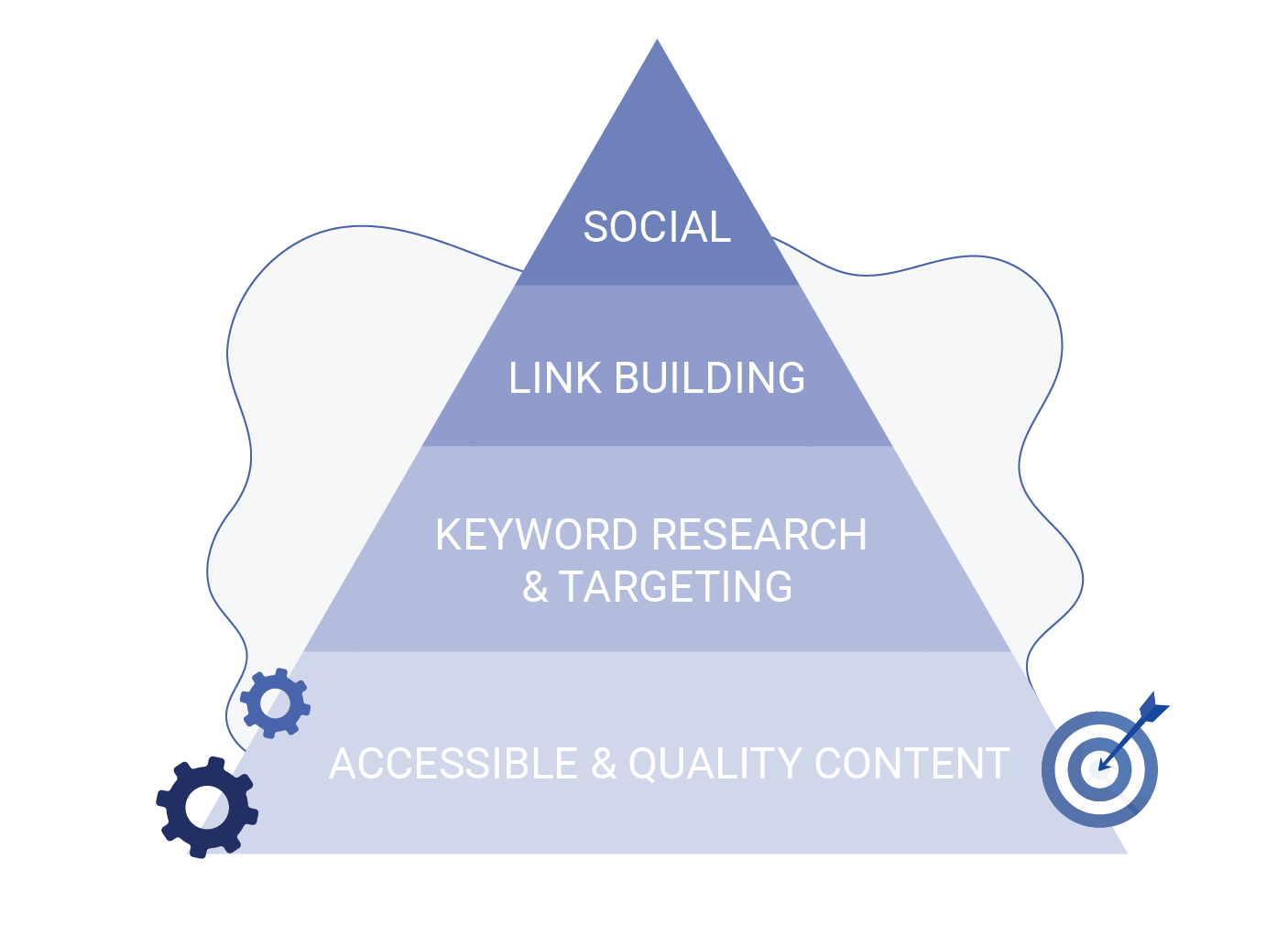In our previous blog post SEO Pyramid Strategy for Small Business – Part 1, we covered the base layer of the SEO triangle.
This involves creating accessible quality content, which includes:
- Unique text based content
- Ensuring your link architecture is optimized
- Bot accessibility – bots can access and understand your content
- Site architecture is optimized so its easy to find all your pages
- Ensuring your URLs are as user friendly as possible
- You have a sitemap in place
In this post, we are going to discuss the second tier of the seo pyramid strategy for small business. And this is the part that focuses on keyword research and on-page targeting. The third tier deals with link building and earning links.
Keyword Research
What is Keyword Research?
This is what you, your team, or your website maintenance virtual assistant do in order to identify search terms that align with what your website is about.
It is an excellent tool for decision making because it allows you to understand what your clients are searching for, and in turn shows you where you should invest time and effort.
Keyword search terms are an excellent indicator of demand,which is useful for validating an idea for a new business, product or offering. Before you put all your money and time into developing a service or product that absolutely no one wants or needs.
It tells us what our prospective clients are looking for, which means we can then create useful, engaging content to match. This increases your credibility and establishes you as an expert.
Is Keyword Research Important in SEO triangle strategy?
YES.
I cannot emphasize the importance of keyword research, enough. I try, but tend to come across as a crazed zealot. Keyword research is everything.
What is Keyword Brainstorming?
All this is, is thinking things through with your team (or on your own) regarding what people are
likely to search for, when they are looking for your product or service.
Think through the most obvious words or phrases – those most commonly used – as well as associated phrases – and the more ‘offical’ terms.
For example, consider the terms ‘rhinoplasty’ and ‘nose job’.
Which terms are YOUR clients more likely to search for?
Include them all at the beginning, and whittle them down as we go along.
Types of Keywords
Tommy Griffith, CEO of Clickminded, which we cannot recommend highly enough, is the last word in smart SEO training. He tells his students and clients to focus on three types of keywords. Core keywords, secondary keywords and accessory keywords.
- A Core Keyword is the main keyword that you have identified to optimize a page for.
- Secondary Keywords are slightly different, but closely related to your page’s core keyword
- Accessory keywords are the terms that come up in the same conversation as your core keyword, but are not directly related. The search volume is lower – and so is the competition.
The most important keyword here is your core keyword. Secondary keywords are still important and you may find that you receive more traffic for your secondary keywords. Accessory keywords are generally helpful to the user and pretty easy to rank for, which makes it worth pursuing.
How on earth do you do all this?
Truth be told, it is easier than you think – provided you have the right tools for the job.
SEO Triangle Keyword Research Tools for Smart Entrepreneurs
Entrepreneurs who try to follow seo triangle principles without the right tools are the ones who end up thinking that SEO is a practice that requires arcane and specialized knowledge. An exercise in frustration.
So let’s look at the Keyword research tools that will make your life a lot easier, and even more enjoyable. Most of the SEO tools available are great and it pretty much comes down to personal preference. In my opinion, these four are worth checking out:
All offer really useful resources including beginner guides to seo and seo best practice as well as in depth tutorials.
If you want a nearly exhaustive list of the best keyword research tools, check out check out Backlinko’s 15 Best Keyword Research Tools for SEO.
Whichever tool you use, you would take the seed terms you identified during your keyword brainstorming sessions, and enter it into your keyword tool. This will provide you with the specific metrics you need to identify opportunities and the keywords you want to optimize for.
Let’s look at these metrics and what they mean.
Making Sense of Keyword Search Metrics

Search Volume
Search volume is an important metric to look at when doing keyword research. By understanding how popular a certain keyword is, you can better determine which keywords to focus your content creation efforts on for your seo triangle.
This is also extremely useful in order to determine whether a new product or service is viable. Search volume tells us how many monthly searches there are for that particular keyword in a month.
It’s worth noting that keywords with a low search volume can still make fantastic accessory keywords. You can create content for accessory keywords and then link them to the page you are optimizing for your core keyword.
Keyword Difficulty or Keyword Competition
Different keyword tools score a keyword’s difficulty in different ways. The terms keyword difficulty and keyword competition are used interchangeably. Don’t try to compare them across tools as you’ll just end up confused. Pick one and stick with it.
For example, Ahrefs scores a keyword’s difficulty (Indicated as KD) between 0 and 100. Keywords with a difficulty of 0 are seen as easy to rank for, whereas a keyword with a KD of 78 is seen as ‘Super hard’. What I like about Ahrefs is it gives you an indication of how many backlinks you would need, in order to rank in the top 10 search results, for a given keyword.
So, for a keyword that scores 78, you would need backlinks from approximately 310 different websites, in order to rank in the top 10.
A KD of 2 means you would only need backlinks from 2 to 3 different websites to rank in the top 10. Although search volume would be significantly lower.
Cost-Per-Click
Why would you look at Cost per Click when dealing with organic search? Afterall, it is a PPC metric?
Basically it signals value. It can help determine the importance of your organic keywords. The thought process here is that the higher the bid on a keyword term, the more people believe it will lead to a conversion.
Not critical, but useful.
User Intent
Search intent is the purpose of a user’s search.
A person’s query indicates where they are in terms of a conversion funnel.
Are they in the beginning stages of their research, or are they sitting there with their wallets in their hands, ready to purchase?
The 4 types of search intent are:
- Navigational intent – they are trying to find something
- Informational intent – they want to learn more about a topic
- Transactional intent – they want to complete a specific action
- Commercial Intent – they want to learn more before making a purchase decision
Providing your users with excellent informational or educational content is a great way to establish yourself as an expert and to build trust.
Transactional keywords are your money makers.
Use transactional keywords on your landing page. Give your users all the relevant information they need, and make it as user friendly as you can. And make the conversion process easy.
The most important factor to remember when it comes to user intent is that your content is relevant to what they are searching for.
Key Takeaways
When done right, keyword research can help produce highly targeted content that engages your readers and leads to more conversions. It’s worth doing and it’s worth doing properly.
You certainly don’t need to do it on your own.
Book a Discovery Call Today and let’s match you with the VA who meets your specific needs. You’ll be amazed at how much time we can save you.





